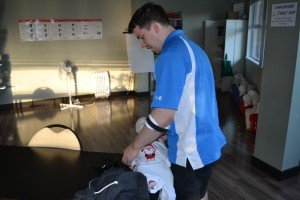Saving a life

According to statistics from the American Heart Association, four out of five cardiac arrests happen at home. This means that four out of five times a heart attack happens, it is happening to someone’s loved one – either a parent, spouse, or a sibling. However, when cardiac arrest happens to a stranger, people often hesitate and ask themselves why they should bother to help. Take in mind these important facts if you encounter a victim of cardiac arrest:
- Giving CPR to a victim within minutes of collapse can double or triple the victim’s survival rate.
- Despite these amazing statistics, only 32 percent of victims of cardiac arrest receive CPR from a bystander and only 8 percent survive.
- To remedy this situation, the AHA and its affiliate providers trains over 12 million rescuers each year.
Getting ACLS training
Advanced Cardiac Life Support is an advanced training course for healthcare professionals. The curriculum involves teaching the students about proper medical management of cardiac arrest. Medical management is done in an organized healthcare environment, such as an emergency room in a hospital. The administration of medication, use of equipment, and performance of diagnostic examinations are all part of ACLS training.
The basic curriculum strutcture in ACLS training is the same as another Advanced Life Support course, PALS (Pediatric Advanced Life Support). The only difference between the two programs is that ACLS teaches the management of adult cases while PALS teaches the management of pediatric cases. The term pediatric means patients under the age of 18, but PALS training covers CPR basics for infants and toddlers/younger children.
ACLS training course: The ACLS program is 16 hours long. It is complete in several sessions over a span of 2 days. Re-certification is completed in a single 5 to 6 hour session.
Basic Life Support
ACLS is built on the basics of Basic Life Support. BLS was created by the American Heart Association to guide rescuers in giving CPR. BLS highlights the use of chest compressions and rescue breaths to help restart the stopped heart. These two basic skills, along with defibrillation, give structure to all CPR courses that we offer. As a training program becomes more advanced, more knowledge and skills are taught to the trainee.
- Chest compressions manually pump the heart to send blood flowing to the rest of the body.
- Rescue breaths oxygenate the blood because in times of cardiac arrest, a victim does not have regular or there is an absence of breathing.
- Defibrillation delivers electrical shock to the heart in order to correct arrhythmia (irregular heart rhythm).
CPR Certificates
CPR training certificates are awarded to students once they finish the program with complete attendance and passing grades on the pre and post-tests. The pre-test consists of a skills and written exam, the same with the post-test (the certification exam).
Before the credential expires, you need to renew it through a re-certification class. We only allow students with valid certificates to sign up for re-certification. If you let your training credential expire, you will have to take the two-day ACLS program again.
